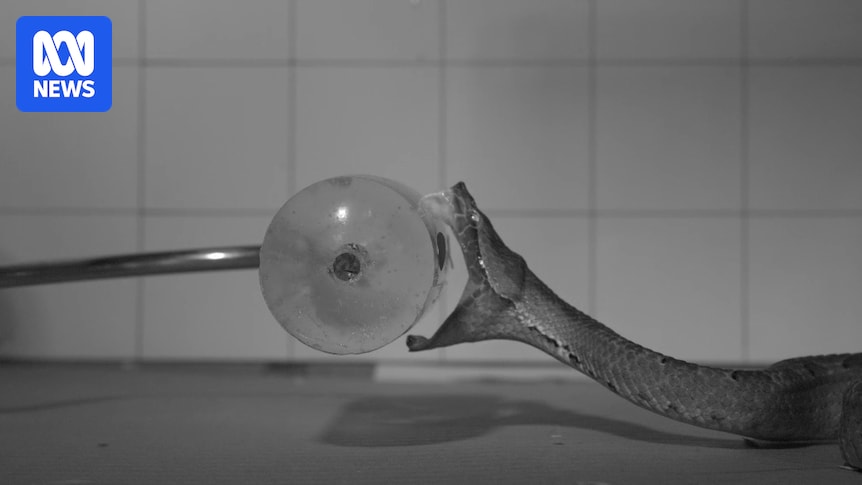
Venomous snakes possess the remarkable ability to strike their prey or defend themselves with lightning speed, often in just a fraction of a second. However, recent research employing high-speed cameras has unveiled the intricate techniques these reptiles use to deliver their deadly venom. This groundbreaking study, led by a team of Australian researchers, offers fresh insights into the diverse striking methods of venomous snakes.
The study, published in the Journal of Experimental Biology, stands as the largest of its kind, comparing how different species of venomous snakes strike their prey under controlled conditions. Silke Cleuren, the study’s lead author and an evolutionary biologist at Monash University, traveled to Venomworld in Paris. This facility, known for breeding snakes to extract venom for medical purposes, provided the perfect setting for Cleuren’s research.
Unveiling the Striking Techniques
Dr. Cleuren and her colleagues meticulously recorded the biting actions of 36 snake species from the viper, elapid, and colubrid families. Among these were the rough-scaled death adder (Acanthophis rugosus) from Australia, the western diamondback rattlesnake (Crotalus atrox), and the West African carpet viper (Echis ocellatus). The team used high-speed cameras to capture the strikes, simulating prey with a warmed-up cylinder of medical gel.
According to Alistair Evans, a study co-author and evolutionary morphologist at Monash University, enticing the snakes to strike was straightforward. “We put eyes on the front of it to make it look like it was an animal-type thing,” Evans explained. “We let them strike at it and captured the strike with high-speed video cameras.” The three-dimensional movements of each snake were reconstructed to calculate factors like speed and acceleration.
Vipers: Masters of Speed
Vipers are renowned for their rapid strikes. The study found that, on average, vipers reached their prey within just 100 milliseconds, approximately three times faster than the blink of a human eye. The blunt-nosed or Levantine viper (Macrovipera lebetina) was the fastest, reaching its target in just over 20 milliseconds.
“If something is moving towards you, you have to see it with enough time to register that it’s moving, and then react to it,” Professor Evans said. “Your brain tells your muscles to move, so less than 100 milliseconds is much, much faster than the mammalian startle response, particularly for large mammals like us.”
Vipers possess hinged fangs, allowing them to have longer teeth that fold into their mouths when not in use. If their initial bite was not satisfactory, vipers would “walk” up their fangs into a better position to inject venom. Vipers dominated the study, comprising 31 of the 36 snake species analyzed at Venomworld.
Timothy Jackson, a snake venom researcher at the University of Melbourne, who was not involved in the study, emphasized the significance of this research. “We don’t see a great deal of this kind of work,” he noted. “They convincingly make the case as to why their own study significantly improves our knowledge.”
Elapids: The Swift Strikers
Most of Australia’s venomous snakes belong to the elapid family, characterized by fangs at the front of their mouths. The Australian rough-scaled death adder (Acanthophis rugosus) was one of four elapids studied. The death adder demonstrated remarkable speed, reaching its prey in about 30 milliseconds and moving at up to 2.21 meters per second.
“Death adders strike extraordinarily quickly and are very much in the viper range … these are incredibly fast strikers,” Dr. Jackson said. “In fact, in terms of reaching maximum velocity, death adders were the second fastest species in the entire study.”
Elapids have shorter fangs than vipers, requiring them to approach their prey more closely before striking repeatedly to inject venom. Dr. Jackson noted that while much of the study confirmed existing knowledge, the quantitative analysis was crucial. “Having all of that quantitative analysis to confirm those intuitions is really important,” he said.
Colubrids: A Unique Approach
The study also included the mangrove or gold-ringed cat snake (Boiga dendrophila) from Southeast Asia, the sole representative of the Colubridae family. This snake’s fangs are located toward the back of its mouth, resulting in a distinct biting style compared to vipers and elapids.
The gold-ringed cat snake reached its maximum gape, or mouth opening, sooner than other species and maintained it for a longer distance. Upon contact, the snake closed its mouth and maneuvered its maxilla, a movable upper jawbone, to create crescent-shaped cuts. The study theorizes that this technique may enhance venom transfer.
Professor Evans acknowledged the limitations of the study, noting that only one Colubridae species was included. “One of the interesting findings of the paper was how different families of snakes use their venom in different ways,” he said. “We were limited by what they had in Paris. But it’s at least the start.”
Implications and Future Research
The research provides a compelling blueprint for future studies on venomous snake strikes worldwide. Dr. Jackson expressed hope that the study’s methodology could be adapted for broader applications. “There’s a real proof of principle here,” he said. “I hope it can be more broadly applied and also potentially modified for other studies.”
While the study enhances our understanding of venomous snakes, it also highlights the challenges of conducting such research, particularly in regions like Australia. Dr. Jackson noted the difficulty in securing funding for behavioral studies and the need for collaboration with venom facilities.
As scientists continue to explore the fascinating world of venomous snakes, this study serves as a vital step in uncovering the secrets of these enigmatic creatures and their deadly strikes.






